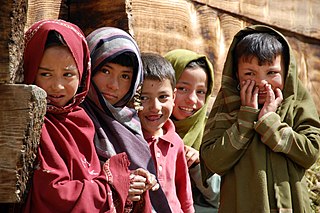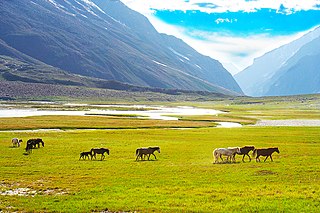
The Tibetic languages form a well-defined group of languages descended from Old Tibetan. According to Tournadre (2014), there are 50 languages, which split into over 200 dialects or could be grouped into 8 dialect continua. These languages are spoken in the Tibetan Plateau and in the Himalayas in Gilgit-Baltistan, Aksai Chin, Ladakh, Nepal, Himachal Pradesh, Uttarakhand, and Bhutan. Classical Tibetan is the major literary language, particularly for its use in Buddhist literature.

The Tibetan script is a segmental writing system (abugida) of Indic origin used to write certain Tibetic languages, including Tibetan, Dzongkha, Sikkimese, Ladakhi, Jirel and Balti. It has also been used for some non-Tibetic languages in close cultural contact with Tibet, such as Thakali and Old Turkic. The printed form is called uchen script while the hand-written cursive form used in everyday writing is called umê script. This writing system is used across the Himalayas, and Tibet.

Ladakh is a region administered by India as a union territory and constitutes an eastern portion of the larger Kashmir region that has been the subject of a dispute between India and Pakistan since 1947 and India and China since 1959. Ladakh is bordered by the Tibet Autonomous Region to the east, the Indian state of Himachal Pradesh to the south, both the Indian-administered union territory of Jammu and Kashmir and the Pakistan-administered Gilgit-Baltistan to the west, and the southwest corner of Xinjiang across the Karakoram Pass in the far north. It extends from the Siachen Glacier in the Karakoram range to the north to the main Great Himalayas to the south. The eastern end, consisting of the uninhabited Aksai Chin plains, is claimed by the Indian Government as part of Ladakh, and has been under Chinese control since 1962.

Balti is a Tibetic language natively spoken by the ethnic Balti people in the Baltistan region of Gilgit-Baltistan, Pakistan, Nubra Valley of the Leh district and in the Kargil district of Ladakh, India. The language differs from Standard Tibetan; many sounds of Old Tibetan that were lost in Standard Tibetan are retained in the Balti language. It also has a simple pitch accent system only in multi-syllabic words while Standard Tibetan has a complex and distinct pitch system that includes tone contour. Due to effects of dominent languages in Pakistani media like Urdu, Punjabi and English and religious impact of Arabic and Persion languages, Balti, like other regional languages of Pakistan, is continously expanding its vocabulary base with loanwords.

Kargil district is a district in Indian-administered Ladakh in the disputed Kashmir-region. It is one of the two districts comprising the Indian-administered union territory of Ladakh. The district headquarters are in the city of Kargil. The district is bounded by the Indian-administered union territory of Jammu and Kashmir to the west, the Pakistani-administered administrative territory of Gilgit–Baltistan to the north, Ladakh's Leh district to the east, and the Indian state of Himachal Pradesh to the south. Encompassing three historical regions known as Purig, Dras and Zanskar, the district lies to the northeast of the Great Himalayas and encompasses the majority of the Zanskar Range. Its population inhabits the river valleys of the Dras, Suru, Wakha Rong, and Zanskar.

The Baltis are a Tibetic ethnic group who are native to the Pakistani-administered territory of Gilgit−Baltistan and the Indian-administered territory of Ladakh, predominantly in the Kargil district with smaller concentrations present in the Leh district. Outside of the Kashmir region, Baltis are scattered throughout Pakistan, with the majority of the diaspora inhabiting prominent urban centres such as Lahore, Karachi, Islamabad and Rawalpindi.

Purgi, Burig, Purki, Purik, Purigi or Puriki is a Tibetic language closely related to the Balti language. Purgi is natively spoken by the Purigpa people in Ladakh region of India and Baltistan region of Pakistan.

Nubra, also called Dumra, is a historical region of Ladakh, India that is currently administered as a subdivision and a tehsil in the Leh district. Its inhabited areas form a tri-armed valley cut by the Nubra and Shyok rivers. Its Tibetan name Dumra means "valley of flowers". Demands have been raised and BJP has hinted at creation of Nubra as a new district. Diskit, the headquarters of Nubra, is 120 km north of Leh, the capital of Ladakh.

Ladakh has a long history with evidence of human settlement from as back as 9000 b.c. It has been a crossroad of high Asia for thousands of years and has seen many cultures, empires and technologies born in its neighbours. As a result of these developments Ladakh has imported many traditions and culture from its neighbours and combining them all gave rise to a unique tradition and culture of its own.

The Suru Valley is a valley in the Kargil District in the Union Territory of Ladakh, India. It is drained by the Suru River, a tributary of the Indus River. The valley's most significant town is Sankoo.

The Brokpa, sometimes referred to as Minaro, are a small ethnic group mostly found in the union territory of Ladakh, India around the villages of Dha and Hanu. Some of the community are also located across the Line of Control in Baltistan in the villages around Ganokh. They speak an Indo-Aryan language called Brokskat. The Brokpa are mostly Vajrayana Buddhist while some are Muslim.
Central Tibetan, also known as Dbus, Ü or Ü-Tsang, is the most widely spoken Tibetic language and the basis of Standard Tibetan.

Kharfaq is a small village with a population of about 2,000 people in Ghanche District, Gilgit-Baltistan, Pakistan. The village is located 3 hours away from Kharfaq Lake, a lake famous for its large trout population.
The Lahuli–Spiti languages are a subgroup of the Tibetic languages spoken in the Lahaul and Spiti region of Himachal Pradesh, India, belonging to the South-Western group of Tibetic languages, earlier classified as Western Innovative Tibetan. They are more closely related to Standard Tibetan than to the neighboring Ladakhi–Balti languages spoken further north.
The first portion of the Bible, the Gospel of John, in a Tibetic language was translated by Moravian Church missionaries William Heyde, Edward Pagel, and Heinrich August Jäschke, and later Dr. August Francke. It was printed in 1862 at Kyelang capital of Lahul in Kashmir. The whole New Testament was printed in 1885 in Ladakh. Another version was translated in 1903. So as not to have the problem of various dialectal differences it was translated into classical Tibetan, but this was not understood by most people. Yoseb Gergen, a Tibetan Christian translated the entire Bible, complete in 1935. This version was translated into a dialect of Tibetan Gergen had accidentally stumbled across, and which was understandable by all Tibetans. It was finally published in 1948. This is known in India as the Tibetan OV Bible. Eliya Tsetan Phuntshog published a New Testament in 1970. There is currently a project going on to translate the Bible into the East Tibetan dialect.
Zangskari dialect is an endangered Tibetic language. It is mostly spoken in the Zanskar region of the Kargil district of Ladakh, India and also by Buddhists in the upper reaches of Lahaul, Himachal Pradesh, and Paddar, Jammu and Kashmir. It is written using the Tibetan script.
The Ladakhi–Balti languages or Western Archaic Tibetan languages are a subgroup of the Tibetic languages spoken in the Ladakh region of India and in the Gilgit-Baltistan territory of Pakistan. The lects lack mutual intelligibility and are considered separate languages by their speakers. The grouping includes:
Stod Bhoti (sTodpa), occasionally known as Lahul Bhoti or Lahuli, is a Tibetic language spoken in the Lahaul and Spiti district of Himachal Pradesh, India. It forms a closely knit group with other Lahuli–Spiti languages, and is fairly close to Standard Tibetan.

The culture of Ladakh refers to the traditional customs, belief systems, and political systems that are followed by Ladakhi people in India. The languages, religions, dance, music, architecture, food, and customs of the Ladakh region are similar to neighboring Tibet. Ladakhi is the traditional language of Ladakh. The popular dances in Ladakh include the khatok chenmo, cham, etc. The people of Ladakh also celebrate several festivals throughout the year, some of the most famous are Hemis Tsechu and Losar.
The Shamskat dialect of the Ladakhi language is spoken in the Sham region of Ladakh, a region administered by India as a union territory. Along the Indus, there is a clear geographical boundary between two dialects of Shamskat and Kenskat. Nimo, the first village of Shamskat speakers, lies in the sharply cut basin near the narrow gorge of Indus river. It is the predominant language in the west of the Buddhist-dominated district of Leh. Shamskat pronunciation resembles that of Old Tibetan. Shamskat retains its Classical Tibetan vocabulary, while the Balti and Purgi have little influence from the vocabulary of its neighbour Shina. The native speakers of these languages are called Shamma.















